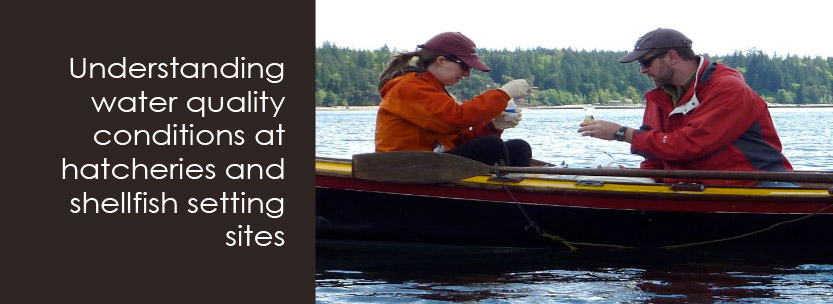|
In the Pacific Northwest and Puget Sound, the combination of upwelled low-pH waters, low alkalinity and increased anthropogenic CO2 create some of the most corrosive conditions in the world’s ocean surface. Organisms that produce a calcium carbonate shell, like shellfish, are considered particularly vulnerable to ocean acidification because such conditions lead to a reduction in the carbonate ion needed for calcification. For the last several years, declining Pacific oyster populations in Willapa Bay, WA were correlated with changes in water conditions that have been attributed to ocean acidification. Beginning 2007, West Coast oyster hatcheries, including those in Dabob and Netarts Bays, have also reported unusually high mortalities of early-stage Pacific oyster larvae, generally associated with upwelled, corrosive deep water.
PSI Senior Biologist, Andy Suhrbier is helping to inform shellfish growers and researchers of pertinent water quality variables near shellfish setting, remote setting and hatchery sites. Andy currently maintains water quality stations around Washington’s Willapa Bay and at the Lummi Lagoon. These stations record, at a minimum, dissolved oxygen (DO), pH, salinity, oxidation reduction potential (ORP) and temperature. Near real-time data is available at Willapa’s Nahcotta and Bay Center sites and can be accessed through the NANOOS (the Pacific Northwest regional ocean observing system) portal (www.nanoos.org/nvs). Water quality data at the Tokeland (Willapa) and Lummi sites also include chlorophyll, which is downloaded on a monthly basis and available upon request. Since August 2012, a CO2 meter has been collecting data at the Nahcotta site so data can be incorporated with pH values to calculate saturation state. Weekly water samples are also taken at all sites to identify levels of nutrients and vibrio bacteria in the water and to determine carbon chemistry variables including pCO2, TCO2 and saturation state. Saturation state is the best variable used to determine the suitability of water for early oyster shell formation.
The data generated by this project is useful to current shellfish production as well as future research. Hatchery and remote setting operations can use the data to decide when to pull water into their tanks. Scientists can also utilize this information for their own projects involving modern estuarine water quality dynamics.
The project team intends to upload near real-time CO2 data from Nahcotta on the NANOOS site in the coming months along with saturation state variables. PSI staff is also looking into opportunities to expand monitoring efforts to other parts of the Puget Sound region, especially near nursery, remote setting and hatchery sites.
This research is supported by the Pacific Coast Shellfish Growers Association.
For more information on this monitoring effort, contact:
Andy Suhrbier
Pacific Shellfish Institute
Tel. 360-754-2741
suhrbier@pacshell.org
|













